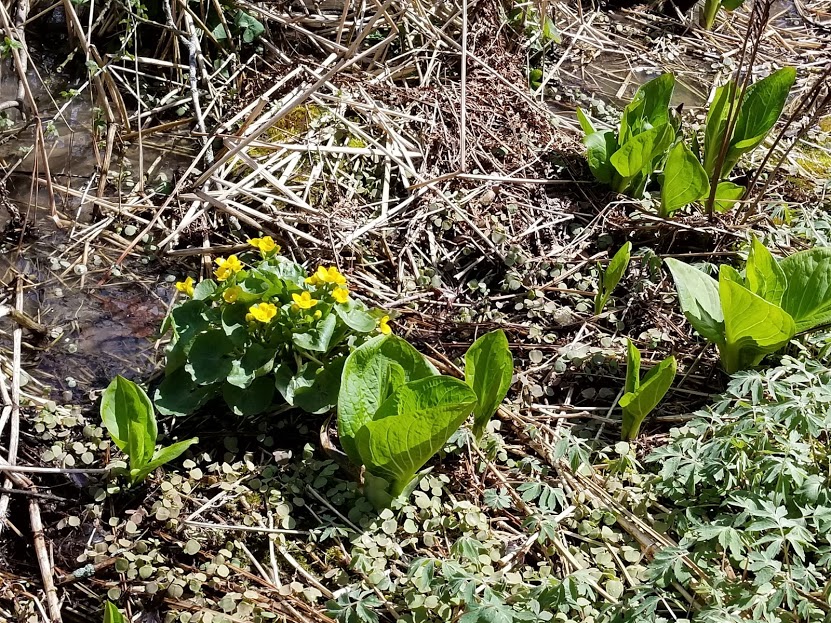If you walk or ride your bike along the Interurban trail between Cedarburg and Mequon, WI this spring, you may notice one of my favorite spring wildflowers in bloom – Marsh Marigold (Caltha palustris.) Look for it in low lying areas, for this plant loves wet soils but can also be grown in rich, well-irrigated garden soils. Marsh marigold, also known as boots, bull flower, cow lily, soldier’s buttons, crazy bet, and other names, is especially useful as a rain garden plant, soaking up urban runoff before it gets into waterways, or along the edges of ponds. Given proper soil conditions, it will slowly spread by underground stems called rhizomes.
Marsh marigold is native to marshes, swamps, wet meadows and stream margins from Newfoundland to Alaska and south to Nebraska, Tennessee, and North Carolina in full sun or part shade. Though ten species of Caltha are recognized world-wide, it is one of only two native to Wisconsin. Closely related to Caltha palustris is Caltha natans, floating marsh marigold, found in ponds and slow-moving streams. In the Badger state it is considered an endangered species. Though the common name of Caltha implies a relationship with marigolds, which is in the aster family, it is more closely aligned with buttercups, the Ranunculaceae family. In Ireland, it is sometimes called Mayflower. On May Day, when Irish folklore believed that witches and fairies were particularly active, bunches of the flowers were hung over doorways to protect the fertility of cattle.
Marsh marigold has a soft, spongy root system from which emerge stout, juicy stems. It may reach two feet in height but usually stays in the 1 1/2-foot range. Leaves are smooth and glossy. Lower leaves reach a spread of 8 inches, while upper leaves are smaller. The foliage may be poisonous to livestock, hence the Irish May Day tradition. Topping the attractive leaves are bright yellow 1 1/2-inch flowers that appear in April and early May. While most flowers have attractive petals surrounded by bland sepals, marsh marigold is a rebel. It has no petals but 5 to 9 showy sepals that appear as petals.
Indigenous Americans gathered the leaves in early spring, before the flowers appear, cooked them thoroughly to destroy toxic alkaloids, and ate them as a green vegetable. Flower buds, which are also a source of yellow dye, can be pickled in vinegar and used as a substitute for capers. Medicinally, marsh marigold was used in early times to treat dropsy, convulsions, coughing, and to remove warts. Because of the alkaloids found in all parts of the plant, it should never be ingested raw.
My first introduction to marsh marigold was when I was teaching at Illinois Central College in East Peoria. Off to the side of the ramp leading from Hwy 116 north to Hwy 24 east was a huge bed of the plant. When they were in bloom, it was a stunning sight. Unfortunately, the area was bulldozed and filled-in in the name of “progress.”
Many other wildflowers, including trillium, toothwort, spring beauty, troutlily, and Virginia bluebells, can be seen along the Interurban trail in early spring. All the more reason to pause your bike ride and admire Mother Nature and her beauty.



